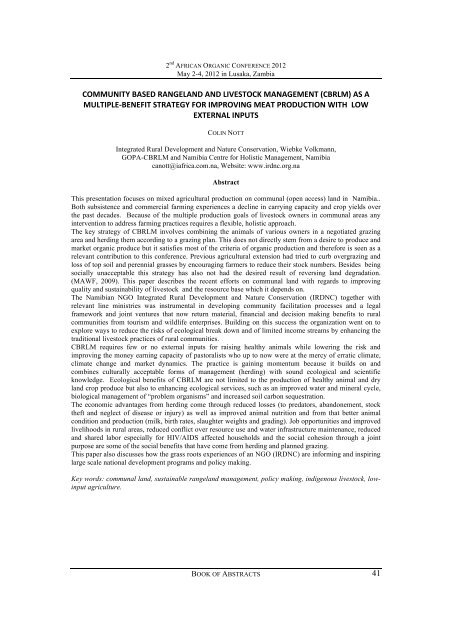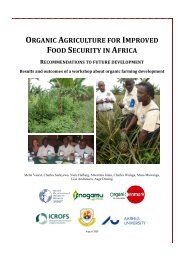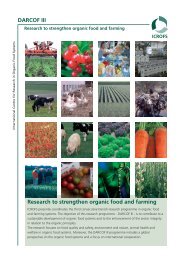The 2nd African Organic Conference â Mainstreaming ... - ICROFS
The 2nd African Organic Conference â Mainstreaming ... - ICROFS
The 2nd African Organic Conference â Mainstreaming ... - ICROFS
You also want an ePaper? Increase the reach of your titles
YUMPU automatically turns print PDFs into web optimized ePapers that Google loves.
2 nd AFRICAN ORGANIC CONFERENCE 2012<br />
May 2-4, 2012 in Lusaka, Zambia<br />
COMMUNITY&BASED&RANGELAND&AND&LIVESTOCK&MANAGEMENT&(CBRLM)&AS&A&<br />
MULTIPLE:BENEFIT&STRATEGY&FOR&IMPROVING&MEAT&PRODUCTION&WITH&&LOW&<br />
EXTERNAL&INPUTS&&<br />
COLIN NOTT<br />
Integrated Rural Development and Nature Conservation, Wiebke Volkmann,<br />
GOPA-CBRLM and Namibia Centre for Holistic Management, Namibia<br />
canott@iafrica.com.na, Website: www.irdnc.org.na<br />
Abstract<br />
This presentation focuses on mixed agricultural production on communal (open access) land in Namibia..<br />
Both subsistence and commercial farming experiences a decline in carrying capacity and crop yields over<br />
the past decades. Because of the multiple production goals of livestock owners in communal areas any<br />
intervention to address farming practices requires a flexible, holistic approach.<br />
<strong>The</strong> key strategy of CBRLM involves combining the animals of various owners in a negotiated grazing<br />
area and herding them according to a grazing plan. This does not directly stem from a desire to produce and<br />
market organic produce but it satisfies most of the criteria of organic production and therefore is seen as a<br />
relevant contribution to this conference. Previous agricultural extension had tried to curb overgrazing and<br />
loss of top soil and perennial grasses by encouraging farmers to reduce their stock numbers. Besides being<br />
socially unacceptable this strategy has also not had the desired result of reversing land degradation.<br />
(MAWF, 2009). This paper describes the recent efforts on communal land with regards to improving<br />
quality and sustainability of livestock and the resource base which it depends on.<br />
<strong>The</strong> Namibian NGO Integrated Rural Development and Nature Conservation (IRDNC) together with<br />
relevant line ministries was instrumental in developing community facilitation processes and a legal<br />
framework and joint ventures that now return material, financial and decision making benefits to rural<br />
communities from tourism and wildlife enterprises. Building on this success the organization went on to<br />
explore ways to reduce the risks of ecological break down and of limited income streams by enhancing the<br />
traditional livestock practices of rural communities.<br />
CBRLM requires few or no external inputs for raising healthy animals while lowering the risk and<br />
improving the money earning capacity of pastoralists who up to now were at the mercy of erratic climate,<br />
climate change and market dynamics. <strong>The</strong> practice is gaining momentum because it builds on and<br />
combines culturally acceptable forms of management (herding) with sound ecological and scientific<br />
knowledge. Ecological benefits of CBRLM are not limited to the production of healthy animal and dry<br />
land crop produce but also to enhancing ecological services, such as an improved water and mineral cycle,<br />
biological management of “problem organisms” and increased soil carbon sequestration.<br />
<strong>The</strong> economic advantages from herding come through reduced losses (to predators, abandonement, stock<br />
theft and neglect of disease or injury) as well as improved animal nutrition and from that better animal<br />
condition and production (milk, birth rates, slaughter weights and grading). Job opportunities and improved<br />
livelihoods in rural areas, reduced conflict over resource use and water infrastructure maintenance, reduced<br />
and shared labor especially for HIV/AIDS affected households and the social cohesion through a joint<br />
purpose are some of the social benefits that have come from herding and planned grazing.<br />
This paper also discusses how the grass roots experiences of an NGO (IRDNC) are informing and inspiring<br />
large scale national development programs and policy making.<br />
Key words: communal land, sustainable rangeland management, policy making, indigenous livestock, lowinput<br />
agriculture.<br />
BOOK OF ABSTRACTS 41





